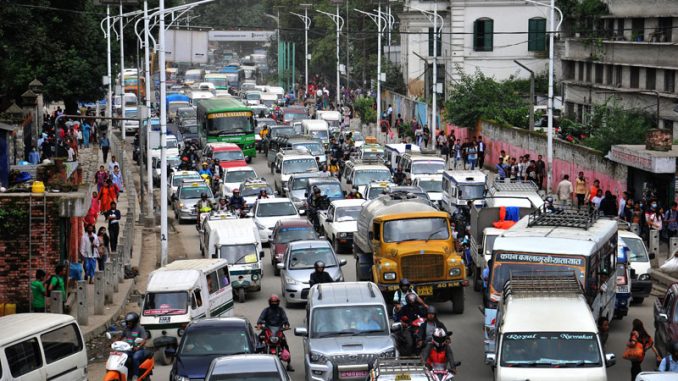

Traffic moves along a road in Kathmandu, Nepal, on Nov. 1, 2017. (Sara Hylton/Bloomberg News)
“In all of South Asia, this is one of the most successful initiatives by the traffic police,” said Madhu Sudan Silwal, a senior police officer who has spent most of his life ushering traffic on Kathmandu’s roads. “This is our pride.”
For many who live in Asia, to drive without honking seems an impossible feat. How else can you express frustration to fellow drivers in rush-hour traffic jams or hurry a jaywalking pedestrian out of your way without shifting your foot from accelerator to brake?
“I wanted drivers in Kathmandu Valley to be civilized,” he said. “Now if you blow the horn, people will look at you, just like in a developed country, as if you were uncivilized.”
The ban was rolled out in Kathmandu at the start of Nepal’s new year in April. It is now being tested in smaller cities, and soon, authorities hope, the entire country will be horn-free.
The small Himalayan nation, sandwiched between India and China, rarely gets to brag about its advancements, as its neighbors zoom ahead on various metrics, sending satellites into space or building glittering new cities and railways. The horn ban, traffic police say, is a mark of Nepali society’s sophistication.
“Now all the foreigners feel Nepal’s people are good,” said Sarbendra Khanal, Kathmandu’s current traffic police chief.
The transformation has been impressive, said Bhushan Tuladhar, chairman of the Kathmandu-based Environment and Public Health Organization. “The streets are more pleasant now,” he said. “Using the horn was just accepted before, even though it was irritating to everyone. Now if you honk, people look at you and say, ‘What the hell are you doing?’ ”
The ban, Tuladhar said, required little more than good enforcement. And it brought about a huge behavioral change in the city.
“Before, your hand just automatically went to the horn,” he said. “You pressed the horn before you hit the brakes.”
At first individually incentivized with a 15 percent cut of the fines, traffic police sprang into action. Since the ban was adopted, police have issued 16,759 fines, although the number issued per month dropped from 3,722 in the first month to 1,422 in the most recent Nepali calendar month. (Nepal does not use the Western calendar.)
Drivers say the roads are safer and friendlier without obnoxious honkers. “It makes our job fun,” said Krishna Manandhar, a taxi driver in the city. “It was totally different before.”
(Pradeep Bashyal contributed to this report.)

Leave a Reply